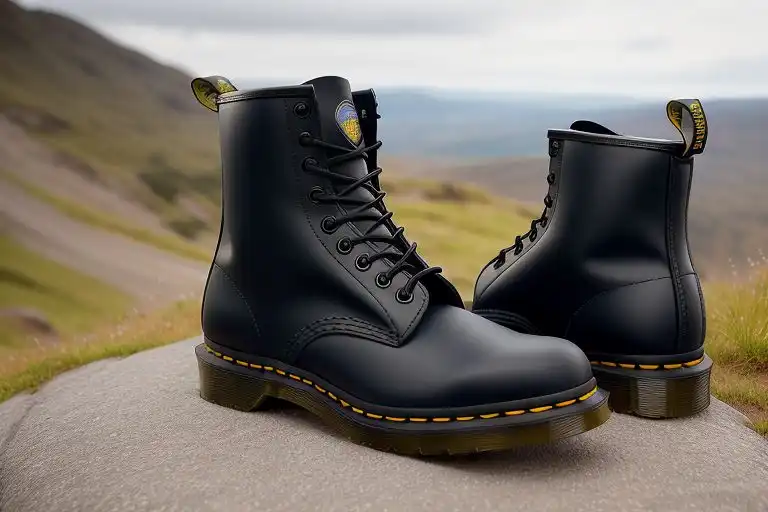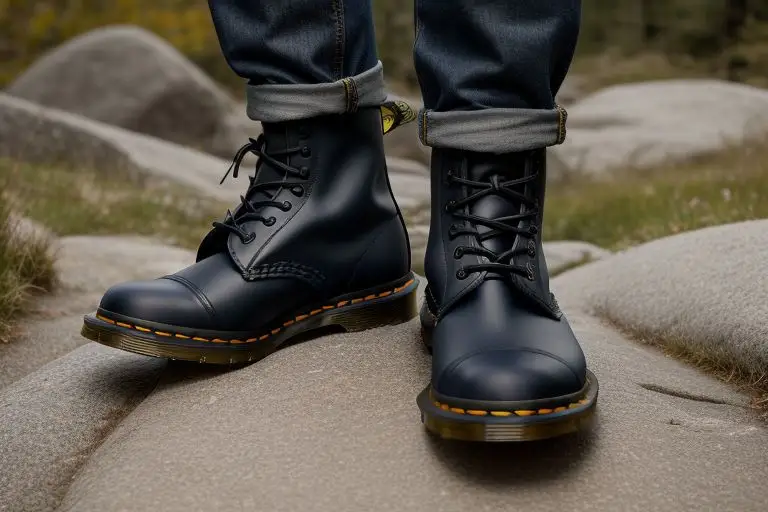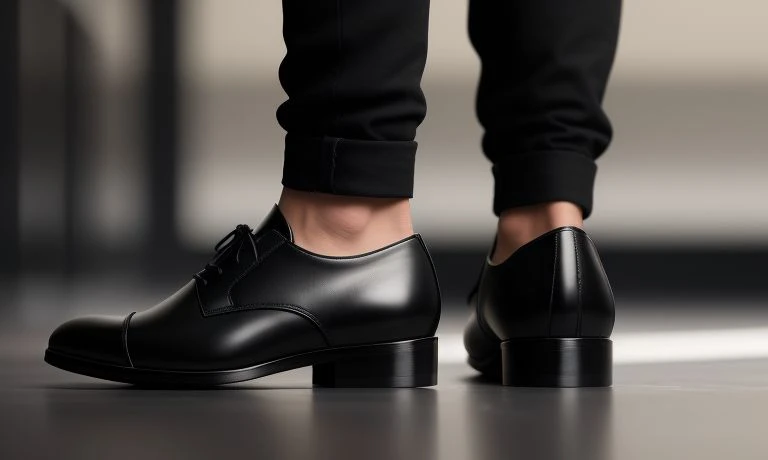Are Doc Martens Good for Hiking? Trail or Trend
Are Doc Martens Good for Hiking? – Doc Martens, iconic footwear that defined an era, is now considered a trendy choice in fashion.
But can they double up as functional hiking boots?
Let’s delve into an in-depth discussion to understand if these boots, with their characteristic yellow stitching and chunky soles, are suitable for hiking.
Table of Contents
Are Doc Martens Good for Hiking?

While Doc Martens have certain features that can be beneficial for light outdoor activities, they may not be ideal for serious, long-distance hiking. This primarily stems from their lack of some essential characteristics found in traditional hiking boots.
For instance, Doc Martens do not feature the deep tread soles common in hiking footwear, limiting their grip and stability on rough or slippery terrain. Their leather construction, though robust and partially water-resistant, does not offer full waterproofing, posing potential discomfort in wet conditions.
Additionally, these boots require an extended break-in period, during which the wearer may experience discomfort and possible blisters. Despite the admirable ankle support they provide, it may not be adequate for uneven hiking trails, where risks of twists and sprains are prevalent.
Lastly, they lack the shock-absorbing features and specialized snug fit that are integral to most hiking boots. Therefore, while Doc Martens may suffice for shorter hikes on well-maintained trails, they may fall short for challenging treks or unpredictable terrains.
The History of Doc Martens and Their Original Purpose

The birth of Doc Martens traces back to 1945 when a German doctor named Dr. Klaus Maertens conceived the design. After sustaining an injury in a skiing accident, he needed footwear that would cushion his healing foot while walking.
As a solution, he engineered a boot with an innovative air-cushioned sole. When these boots hit the market, they were quickly adopted by factory workers in Britain who appreciated their robustness and comfort during long work hours.
This marked the beginning of the boots’ reputation for durability, even though their original design was centered on recovery rather than enduring rigorous outdoor activities or catering to fashion trends.
It’s interesting to note how over the years, these practical work boots have crossed over into various subcultures, transforming into a statement of style and identity. Yet, their original purpose and design remain central to their structure, influencing how they perform today as potential hiking footwear.
Analyzing the Features of Doc Martens
The reputation of Doc Martens as robust and stylish footwear extends beyond their distinct aesthetic. The construction of these boots involves a unique blend of features that cater to different needs. First off, their air-cushioned soles stand out. This patented technology is designed to provide a high level of comfort, making prolonged standing or walking more bearable.
While they are constructed with a leather upper, it’s crucial to clarify that this leather is not entirely waterproof, but it does provide a certain degree of water resistance. However, continuous exposure to water or damp conditions may lead to the penetration of moisture, making your feet uncomfortable during hikes.
As for the soles, while they are quite slip-resistant, they don’t have deep treads that are common in hiking boots. Deep treads provide superior traction and grip on slippery, muddy, or uneven terrains, which is an essential feature for hikers that Doc Martens lack.
Another factor to consider is the ankle support provided by these boots. Given their high-top design, Doc Martens provide adequate support to the ankles, reducing the risk of injury from twists or sprains, particularly on uneven terrains.
However, it’s also worth noting that these boots require a significant break-in period before they mold to the shape of your feet and reach their maximum comfort level. During this period, there might be some level of discomfort, potentially leading to blisters or sore spots.
Comparing Doc Martens to Traditional Hiking Boots
When we measure Doc Martens against conventional hiking boots, certain differences become apparent. Hiking boots are specifically designed keeping in mind the challenges and demands of rigorous outdoor expeditions.
Unlike Doc Martens, hiking boots have deep treads on the soles to ensure maximum grip and traction, even on slippery or rugged terrains. This feature is crucial for a secure and stable footing, especially when navigating uneven paths.
While the high-top design of Doc Martens offers some ankle support, hiking boots often come with additional padding and reinforced ankle support for added stability. This significantly reduces the risk of twists or sprains, which are common concerns on hiking trails.
Waterproofing is another key aspect where hiking boots outperform Doc Martens. Unlike the latter, hiking boots are engineered to be fully waterproof, ensuring dry and comfortable feet irrespective of the weather conditions or landscape. This is particularly helpful when dealing with unexpected rain, wet environments or crossing water bodies.
Another crucial feature in hiking boots is the snug fit they offer. A well-fitting hiking boot minimizes friction and movement inside the shoe, reducing the chances of developing blisters during long treks.
Most hiking boots also come with padded insoles and effective shock absorption mechanisms. These features help to minimize fatigue and maintain comfort over extended periods of strenuous walking, something which is not offered by Doc Martens.
Lastly, while Doc Martens require a considerable break-in period to achieve maximum comfort, most hiking boots are designed to be comfortable right from the start, reducing the risk of discomfort during initial usage.
Thus, while Doc Martens bring style and durability to the table, when it comes to technical aspects and specialized features designed for the demands of hiking, traditional hiking boots have a clear advantage.
Practical Experience of Hiking with Doc Martens
From those who have ventured out on trails in Doc Martens, the feedback varies. Some hikers have reported that their Doc Martens were adequately comfortable for shorter hikes on trails that are well-groomed and maintained.
They found the boots to provide sufficient support and comfort for these less demanding excursions. On the other hand, hikers embarking on longer walks noted discomfort after prolonged periods, with some mentioning sore feet as a common complaint.
Waterproofing, or the lack thereof, appears to be a common issue amongst hikers wearing Doc Martens. Hiking scenarios involving stream crossing or unexpected showers often resulted in damp, uncomfortable feet due to the boots’ lack of complete water resistance. This further underscores the need for waterproof footwear when embarking on unpredictable trails.
The break-in period required by Doc Martens is another significant point raised by hikers. As these boots need a substantial amount of time to shape themselves around the feet and reach optimal comfort levels, initial hikes could potentially result in discomfort and blisters. Some hikers suggest that thicker socks can help in minimizing the chances of developing blisters during this period.
In summary, while some have successfully managed shorter, less demanding hikes in their Doc Martens, others encountered issues on longer or more challenging trails. Waterproofing concerns and an extensive break-in period appear to be the key factors affecting their suitability for longer hikes.
The Verdict: Are Doc Martens Good for Hiking?
After evaluating the factors, it’s clear that Doc Martens may not be the best option for hardcore hiking activities. While their sturdy construction and air-cushioned soles make them a great choice for leisurely strolls on even paths or light outdoor adventures, they fall short when it comes to the rigors of serious hiking.
Lack of complete waterproofing and the absence of deep tread soles are key limitations for traversing wet or challenging terrains.
Although they provide decent ankle support, it may not be enough to prevent sprains or twists on uneven trails, a risk often mitigated by the reinforced ankle support of traditional hiking boots.
Moreover, the break-in period needed for Doc Martens to reach maximum comfort can potentially lead to blisters or discomfort, a risk rarely encountered with hiking boots that are designed to be comfortable from the get-go.
So, while you may manage to take your Doc Martens for shorter hikes on well-groomed trails, longer hikes across rugged terrains would be better handled by specialized hiking boots. In the end, it’s about understanding the limitations of your gear and making a choice that suits your hiking needs best.
For hiking enthusiasts looking for a pair of boots to weather all conditions and terrains, traditional hiking boots would be the smarter choice over Doc Martens.
How to Make Doc Martens More Suitable for Hiking
Despite their limitations, if you are committed to incorporating your Doc Martens into your hiking gear, there are several adjustments you can make to enhance their suitability for the trail. First, you can apply a leather waterproofing treatment to enhance the water-resistance of the boots.
This can help to some extent in keeping your feet dry during damp conditions. It’s important to note, however, that this treatment will not make them completely waterproof, like traditional hiking boots.
Adding aftermarket insoles is another modification you can consider. These can provide extra cushioning and arch support, enhancing comfort during your hike. Bear in mind that not all insoles are the same, and it is crucial to choose one that fits well with your foot shape and the design of your boots.
You may also want to consider using thick, well-fitted socks when wearing your Doc Martens. These can help to minimize friction, reduce the risk of blisters, and provide additional padding during the boots’ break-in period. Opt for socks that wick moisture away from your feet, keeping them dry and reducing the risk of developing blisters.
Lastly, remember that even with these modifications, Doc Martens still fall short when compared to dedicated hiking boots, especially for challenging or longer hikes. These adjustments can provide some improvements, but they won’t completely transform your boots into fully-equipped hiking gear.
Therefore, for hikes involving rugged terrains or unpredictable weather conditions, it’s always advisable to choose footwear specifically designed for those demands.








